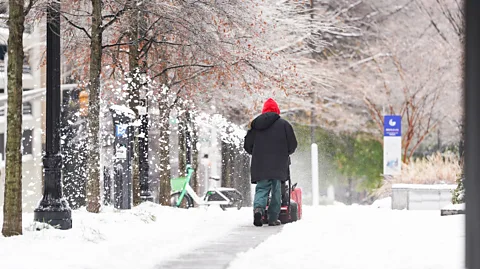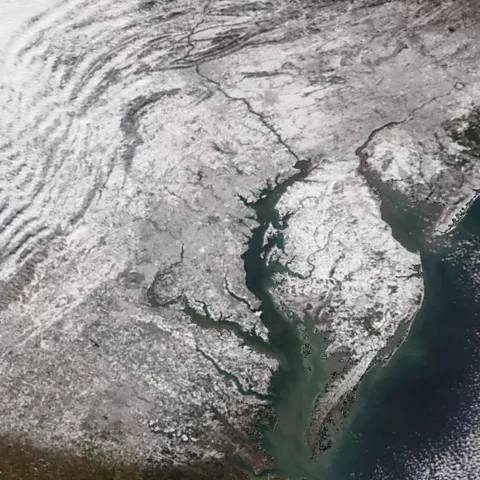How the polar vortex fuels intense winter weather in the US
 Getty Images
Getty ImagesHere's how the polar vortex, and climate change, influence extremely cold winter weather in the US.
Intense snowy wintry weather in the US has been fuelled by activity of the polar vortex, slipping down to engulf large parts of the country.
Early January's winter storm prompted seven states to declare states of emergency, with flights suspended, businesses shuttered and one area in New York recording 6.25ft (1.9m) of snowfall in just 24 hours. Another wave of Arctic air has kept temperatures lower than average through to the middle of January, and parts of the Midwest to the Appalachians and Atlantic Seaboard are expecting further wintry storms.
This blast of cold weather is due to activity of the polar vortex.
What is the polar vortex?
The polar vortex, or Arctic polar vortex, is a ring of strong westerly winds that form between 10 and 30 miles (16-48km) above the North Pole every winter, enclosing a large pool of extremely cold air. The stronger the winds, the more air inside is isolated from warmer areas. When the vortex is stable, the polar jet stream shifts northward, helping to keep the coldest air within the Arctic.
However, when this stable scenario breaks down, it can mean an intense cold snap at mid-latitudes, where the US lies. When the vortex weakens, its pattern of winds changes from a circular ring to a wavy band that loops further south. This unleashes the cold weather normally retained at the pole further to the south.
The polar vortex doesn't always influence the weather in the mid-latitudes, but when it does the effects can be extreme.
 Noaa
Noaa"[The early January] cold outbreak and the one through the 16 January are basically broken off pieces of the polar vortex," Brett Anderson, senior meteorologist at AccuWeather, tells the BBC. "[It's] like a large chunk of ice that breaks off of a glacier and floats southward with the current – with the current being the jet stream winds."
Does climate change affect the polar vortex?
It is not known whether climate change will affect the polar vortex, says Amy Butler, an atmospheric scientist at the National Oceanic and Atmospheric Administration, and an expert on the polar vortex. There are several reasons why it is so hard to predict whether polar vortexes will strengthen or weaken in years to come.
"There are many things that can change the strength of the polar vortex," Butler says. Sea ice is one of them – some models suggest melting sea ice may have a weakening effect on the vortex. However, warming in the upper layers of the atmosphere can potentially strengthen the vortex. Regional changes in sea surface temperatures could also influence the vortex.
"For these reasons, models show no agreement in what will happen to the Northern Hemisphere polar vortex in the future," says Butler.
How are winter storms changing in the US?
In many parts of the US, total snowfall has decreased since official records began in the 1930s. The Pacific Northwest and parts of the Midwest have seen a decrease, although the Great Lakes receive more snow in the past – albeit by a modest amount.
One reason for this overall decline in snowfall is because more winter precipitation is falling in the form of rain instead of snow – and that's because of warmer air temperatures due to climate change. Between 1949 and 2024, more than 80% of weather stations positioned in the contiguous 48 states have measured a decrease in the proportion of precipitation falling as snow. In addition, snow cover – the area of land covered by snow – has decreased by an average of 2,083 sq mi (5,395sq km) a year since 1972.
 Getty Images
Getty ImagesOverall, cold snaps in North America have become less frequent and less extreme. However, when they do occur, in North America or elsewhere, they can be more dangerous precisely because they are rarer, and societies are less well adapted.
Other changes, too, could make cold snaps harder to prepare for with climate change. "It's possible that the type of precipitation could change, leading to some regions seeing more snow, and other regions seeing more ice or sleet events, which could have bigger impacts for, for example, transportation, than snow," Butler says. "However, still other regions may see much less snow, which could strain regions dependent on snowpack for water." For the western US, snowmelt provides 75% of the water supply.
There may be unexpected influences from climate change too. When winter storms do happen, they can sometimes be more intense because of a warmer atmosphere, says Anderson, because a warmer atmosphere can hold more moisture that can fall as precipitation. Snow needs two basic conditions: freezing temperatures and moisture in the atmosphere. And while there are fewer freezes – winter is the fastest warming season across most of the US – Earth's warming atmosphere now holds more moisture.
"I think with a continuation of warming, especially in the oceans there will be more available energy and moisture for bigger winter storms," Anderson adds, "which can be in the form of extreme amounts of rain or snow. However, we are seeing a trend of increasing rain or mix-events compared to just snow."
Anderson does point out that he does not have an answer as to whether or not this particular cold outbreak has anything to do with climate change. However, we can expect climate change to continue to cause "short term variability" in the weather, he says.
The overarching global trend for snow is very clear, Butler notes: cold extremes are becoming less frequent and less severe with climate change. But snow will continue to bring winter challenges in a warmer world, and local effects may vary widely.
Anderson agrees that in the long term, the big picture is plain to see. "There will still be cold and snowy winters in many areas from time to time, but over a long period of time, several decades or more, these cold outbreaks will likely become even less common," he says. "Climate scientists focus on the long-term trends (30 years or more) and they all clearly show an undeniable warming trend that is strongly induced by human activities."
--
For essential climate news and hopeful developments to your inbox, sign up to the Future Earth newsletter, while The Essential List delivers a handpicked selection of features and insights twice a week.
